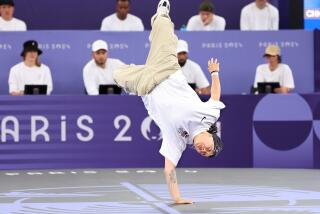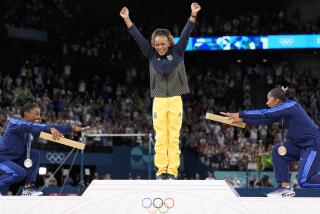Sprinters Make Dubious Moves
- Share via
Two months ago, 100-meter world-record holder Tim Montgomery made an interesting observation while discussing his relationship with Marion Jones.
“My father and mother always told me the company that you keep is what you’re going to be,” he said. “If you keep bad company, you’re going to end up bad. Being in good company, such as an athlete like Marion, is going to bring out the good side of me.”
What does it say, then, that both have been seen training in the company of Charlie Francis, banned for life by Athletics Canada after admitting he’d provided steroids to disqualified Seoul 100-meter gold medalist Ben Johnson?
It’s the second curious move for Jones and Montgomery. Last week, Jones left coach Trevor Graham, saying, “I have a huge need for specific biomechanical analysis that can assist me in the identification of certain fundamental technical deficiencies, the correction of which may be required from time to time to improve my performances.”
She chose as her new coach Derek Hansen, a little-known Canadian who specializes in plyometrics and stretching techniques.
Montgomery, who set the world record of 9.78 seconds in September, joined Jones in switching to Hansen. Both were photographed this week working with Hansen and Francis at York University in Toronto, but Francis told Canadian reporters he doesn’t comment about anyone he coaches. Charles Wells, the agent for Jones and Montgomery, couldn’t be reached Thursday. He’d said this week, before Jones and Montgomery were spotted with Francis, that Jones would continue to live and train in Raleigh, N.C.
Francis gave damning testimony about Johnson during a 1989 inquiry into Johnson’s positive test for anabolic steroids after being clocked in 9.79 seconds at Seoul. Francis and Johnson’s doctor, Jamie Astaphan, testified that Johnson had taken steroids and human growth hormone since 1981. In his book “Speed Trap,” Francis said the success of East German athletes at the 1976 Olympics convinced him that drugs were necessary for success. He was also known as a savvy coach, however.
“If these American athletes want to train with the best coach in the world and get the best advice, they can come to him and he can offer that service,” Johnson told the Canadian Press. “Charlie has an eye to see what they’re doing wrong, what they can achieve, where they can make some necessary adjustment, who is going to help them get that extra yard. And that yard will be a hundredth of a second.”
Jones largely escaped the taint surrounding her ex-husband, shotputter C.J. Hunter, who was banned for two years in 2000 after he tested positive for nandrolone. For Jones, admittedly disappointed she hasn’t improved the personal-best 100-meter time of 10.65 seconds she set in 1998, the lure of running a hundredth of a second faster could be strong enough to outweigh the potential stigma of working with Francis.
Puck Boom Hits Home
If Wayne Gretzky hadn’t played for the Kings, Brett Sterling might not be where he is today, preparing to play for the U.S. in the World Junior Hockey Championships next week in Halifax and Sydney, Canada.
Sterling, 18, was born and raised in Pasadena. Now a freshman at Colorado College, he was 4 when Gretzky was traded by Edmonton to the Kings in 1988 and benefited from the boom Gretzky triggered in ice and roller hockey.
“Back when I started, there really wasn’t anything going on in Southern California in terms of youth hockey,” Sterling said. “As I hit my teens, a lot of programs were getting underway.... I was a King fan. I always have been. My cousin and my older brother played and I started playing because of them. Playing in the NHL has been my dream, and every year I get a little more optimistic.”
Sterling, who left home after his sophomore year in high school to participate in the U.S. national development program, will be eligible for the NHL draft next June. He’s merely 5 feet 8 and 165 pounds, but he impressed U.S. junior coach Lou Vairo during a summer training camp for young U.S. and Finnish players at Lake Placid, N.Y.
“I think this guy is very special,” Vairo said. “He’s a great competitor and has a wonderful sense of how to get open.
“The easiest thing in the world is to teach a guy how to play defensively. You can’t teach someone how to score.
“I predict he will have a wonderful future in the game. I’d take a chance on him anytime.”
The 10 teams were divided into two groups of five for the junior tournament. The top three from each group will advance and cross over to play teams from the other group.
The U.S., which finished fifth last year, opens next Thursday at Sydney against defending champion Russia.
“It’s quite an honor any time you get to put on the USA crest,” said Sterling, whose parents, Bill and Terry, will be in Canada to watch him. “To play with and against the best guys in the world is a big thrill.”
Leaps of Faith
Miki Ando of Japan became the first female skater to land a verified quadruple jump in competition when she did a quadruple salchow at last weekend’s Junior Grand Prix Final at The Hague, the Netherlands. Ando, 14, finished third.
Veteran coach John Nicks, an advocate of raising the technical ante for women, applauded Ando’s feat. Under his guidance, Sasha Cohen landed several quad salchows in practice but not in competition. Cohen has since left Nicks for Tatiana Tarasova and put the quad on hold.
“It’s about time,” Nicks said. “As soon as one person makes a breakthrough, a lot of people will follow through the door. The first guy did a triple axel [in 1978] and then 10 did it and now it’s a requirement.”
Yukari Nakano of Japan and Ludmila Nelidina of Russia landed triple axels in October at Skate America, the first women to perform the 3 1/2-revolution jump in competition in a decade. But the real test will be if they -- and Ando -- can avoid the injuries such jumps often inflict on young bodies.
One such victim is Naomi Nari Nam of Irvine, out of competition since the 1999-2000 season because of hip problems. Nicks said she resumed serious training about three months ago and is regaining her triple jumps.
“I expect her to be competing next year,” he said of Nam, 17.
Here and There
Olympic figure skating gold medalist Sarah Hughes’ first TV special, “Sarah Hughes, a Life in Balance,” will air on NBC Wednesday. The hourlong show details how her life has changed since Salt Lake City and includes four new routines choreographed by coach Robin Wagner.
The U.S. women’s water polo team, which lost the Olympic gold medal at Sydney on a late goal by Australia, lost the title game of the FINA Women’s World Cup last weekend on a goal by Agnes Primasz of Hungary with 45 seconds to play. The U.S. had the best goal differential in the tournament, plus-16, on 37 goals for and 21 against.
More to Read
Go beyond the scoreboard
Get the latest on L.A.'s teams in the daily Sports Report newsletter.
You may occasionally receive promotional content from the Los Angeles Times.








